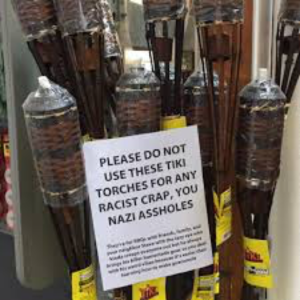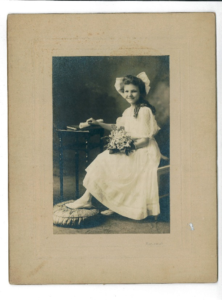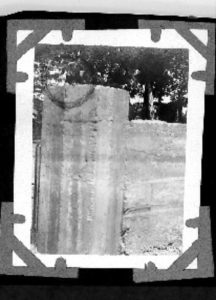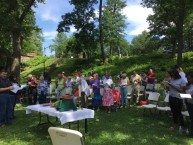[Our guest preacher was our Dir. of Music, William Davies. For more information about him, click here: Music. This sermon is thought provoking and prophetic. The use of images was integral, and so they are included. The audio (available below) appears to be longer than the sermon actually was. It was left on through the end of the service, so you are able to listen to the post sermon service if you like.]
September 17, 2017: Today I’d like to talk with you about three things: Tiki torches, family photos, and a little black dog.
I will bet that as soon as I said “tiki torches,” some of you guessed immediately that I was not referring to a summer barbecue.  Those mundane illuminators of backyard leisure gained sudden notoriety this summer as white supremacists used them for a torchlight gathering on the campus of the University of Virginia in Charlottesville, during which they variously defended a statue of Robert E. Lee, proclaimed the solidarity of white Christians, and chanted slogans such as “Jews will not replace us!” in confrontations with counter-protestors, confrontations that eventually left a young woman dead and others injured, after a neo-Nazi sympathizer rammed his car into a crowd.
Those mundane illuminators of backyard leisure gained sudden notoriety this summer as white supremacists used them for a torchlight gathering on the campus of the University of Virginia in Charlottesville, during which they variously defended a statue of Robert E. Lee, proclaimed the solidarity of white Christians, and chanted slogans such as “Jews will not replace us!” in confrontations with counter-protestors, confrontations that eventually left a young woman dead and others injured, after a neo-Nazi sympathizer rammed his car into a crowd.
Most people — including apparently the owner of this Virginia store  – seem to have found it pretty easy to condemn white racism, anti-Semitism and bigotry in general – and even the misappropriation of the lowly tiki torch as an unwitting prop in a down-market attempt at re-enacting Hitler’s Nuremberg rallies.
– seem to have found it pretty easy to condemn white racism, anti-Semitism and bigotry in general – and even the misappropriation of the lowly tiki torch as an unwitting prop in a down-market attempt at re-enacting Hitler’s Nuremberg rallies.
I’m confident in assuming that no one in this room has ever been tempted to join the Klan or attend a rally of white supremacists. That makes it easy for us to join in condemning what those groups did in Charlottesville in August. I dare say we feel affirmed in our righteousness, and not without reason.
But my purpose this morning is not to celebrate that reassuring moral stance. I think we need to bring the question closer to home and domesticate it. That task brings me to the family photos.
 This is Agnes Smith, and she needs a little explanation.
This is Agnes Smith, and she needs a little explanation.
Agnes was born in 1900 in Nashville, Tennessee. She is a teenager in this photo, which was taken when she was confirmed in her local church, in the years preceding World War I. Agnes married my grandfather in 1921 and was my father’s mother. In my family, she has only ever been referred to as “my father’s mother” to distinguish her from “my grandmother,” the name everyone used to refer to my father’s stepmother and the grandmother I actually knew. Agnes, you see, died of tuberculosis at the age of 28 when my father was only 5 years old, and almost 30 years before I was born. My grandfather, I think, was utterly devastated by her death, and one of the results of that devastation was that he rarely spoke of her. His silence, plus the fact that she died so long ago, has meant that she has always been that intimate figure that nobody knows, a figure of the mysterious historical present who, because she died so young, endures in our somewhat fictive memories as eternally young and pretty, a bride and young mother idealized, but not really known. The Agnes of a hundred years ago is the Agnes of today.
Imagine then how pleased we were to discover a photo album in my grandfather’s attic soon after his death. He seems to have put it together when he was dating – they would have said “courting” in those days – my father’s mother and getting to know her family in Nashville, and into the years when they were first married and living in Bergen County. I still remember first opening the album with my father and paging through it. It was alien territory to both of us. My father could identify little that we found, except for early pictures of his father, his mother, and a few family pets who had lived on into his childhood. He didn’t know about this pet, though.

This is a bad photo, so it’s hard to see that, sitting on top of this concrete wall, there is a small black dog. Everyone in my family has a soft spot for dogs, so there are lots of photos of them. This little guy is cute, his photo pasted on a page that also shows some people on a swimming expedition, some local sights around Nashville and Murfreesboro, and preparations for a parade of troops returning from the European war. The problem is that this slide doesn’t show you the caption to the photo.
You see, the little black dog had a name.

There it is in my grandfather’s unmistakable hand, sitting on the page, white over black, the word that author Randall Kennedy recently called, “the nuclear bomb of racial epithets.” Turning the page in that ancient book of photos introduced a new reality to the family myth: Pretty, young, tragic Agnes had a family dog named “Nigger.”
Your first reaction to this slide, like my first reaction in turning the page to find the original photo, may be shock. That’s probably right, but it doesn’t get either us as a group or me as an individual very far along the path to understanding what it means to juxtapose lovely Agnes Smith to an ugly racial slur. It isn’t enough merely to react viscerally; meaningful reaction demands that we first grasp meaning.
The door into the understanding of meaning in this instance is, I think, to assert that Kennedy is only partly correct, or perhaps only correct in one historical context, in calling the N-word “the nuclear bomb of racial epithets.” In the early 20th century, unlike today, this now unutterable slur was in common use, and not only in the South. It was less a nuclear bomb – a devastating explosion of fissionable hatred – than it was the handy handgun of casual white supremacy, as capable of repeated wounding as of mass slaughter. Understanding meaning in this case is as easy as thinking about the daily rituals of owning a pet.
It’s time to feed the dog: “C’mon, Nigger, time for dinner!” The dog rolls over or sits up: “Atta boy, Nigger!” The dog is outside and you want him to come in: “Come, Nigger! Inside, Nigger!” No one has put on a white sheet; no one has burned a cross, or lit a tiki torch. But the white folks can chuckle at the dog’s clever name, and any black folks who may happen to hear — a maid? the person who rakes up your leaves? – will hear the quotidian derision in the use of that name to identify a dog.
But let’s give Agnes her due. If we could somehow confront her with all of this, what might she say? I think you can easily conjure the response. “Oh, it’s just a little joke; no one means anything by it.” “You don’t understand! We love the dog. We wouldn’t call him anything hateful. Why, he’s just like part of the family!” No nuclear bomb here. Just a beloved little black thing that we own.
How am I to make meaning out of my relationship to Agnes Smith? It’s an interesting and, I think, illustrative question. There’s a real sense in which I have nothing to do with any of this. I never knew her, and I’ve never met any of the Smith family. I’ve never even been to Tennessee. But Agnes Smith and I share some DNA. She is, in that very literal sense, part of me. Those of you who like metaphor and symbol need look no further, because this isn’t just about Agnes Smith and me, nor is it just about race. It’s about our collective participation in evil and about the ways in which we counter it with good.
It is too easy to imagine that the evils of prejudice, bigotry and hatred are limited to the “nuclear bomb” moments, moments when screaming people emerge from under a rock spouting racial epithets, or anti-Semitic slurs; moments when incidents of sexual assault make clear that women are still the objects of a kind of hatred whose power is expressed in rape; moments when gay men or lesbians are attacked because they held hands in public or just “acted too gay.” It’s easy to distance ourselves from the perpetrators of those crimes. Surely we are not like those hateful people! “That’s not,” we often hear our fellow citizens say, “who we really are.” Except that it is, because it keeps happening, and it keeps happening here. The philosopher Hannah Arendt famously wrote, in considering Nazi Germany, about the ”banality of evil,” the fact that the evil of German National Socialism could be found as much in its boring “everyday-ness” as in the bombastic rantings of Hitler and his ilk.
It’s easy to imagine, too, that the way to eliminate these blights on our society lies in marches on Washington, in counter-demonstrations, maybe in Antifa. It’s probably true that at least some of those are important, but none of them is where we live. We live in our everyday-ness. We live at work, at school and at church, in our cars, in places where, because we have only ourselves to police us, we can say whatever we want. What we say is usually banal. Sometimes we’re “just joking around.” Sometimes we’d “Never say that if someone were around who would be hurt by it.” Sometimes we say we haven’t invited someone to a gathering because, “She just wouldn’t fit in with us”
And so, every day, we choose, in a thousand little ways, not whether to drop a nuclear bomb, but how we will use the handgun we all carry. And, make no mistake, we all carry one, whether we’re white or black or male or female or gay or straight. The handgun comes with our cultural DNA. The question we face is how we will handle the weapon. That question is critical not only to the effect we will have on others, but also to determining the sort of community we will build and to the way we will be. The edifice of individual character and of social justice is built over a lifetime of a thousand small stones. The structure is never flawless, but taking care in how we build it can make it beautiful none the less.
It helps, during the building, to remember that we live here, in the back yard with a little dog who has a name.
For the audio from the 10:30am service, click here:





